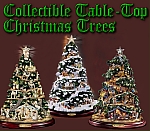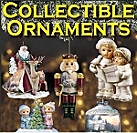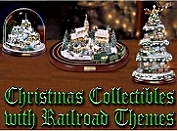| Written by Paul Race for Family Christmas OnlineTM |
How Much is My Collectible Worth?This is a question we get all the time from people who've come across or inherited some interesting object that they want to know more about. The short answer is that your collectible is worth whatever an interested party is willing to pay for it when you're ready to sell it. Unfortunately that's a bit hard to determine, especially if you don't know much about the piece you have, or the demand for that sort of thing.It's also a hard question for me to answer honestly, even if I know the answer, because most inquirers have an emotional investment in the item they're asking about. A better way of phrasing the question might be: "This was my grandfather's, and I wouldn't part with it for a thousand dollars, but I'd just like to know what I could get out of it if I ever had to sell it." Most collectors and appraisers understand this, or they imagine that the person is asking for insurance purposes, so they inflate the market value of the item just to make people feel better. You even see this on "Antique Road Show" - they say things like, "If I had this on auction, I'd be hoping to get, say, $5,000 out of it." What they don't say is "If you had to sell this in a hurry, and didn't have time to wait for the right buyer, you probably shouldn't count on getting more than a hundred." Both answers are correct. Which answer would you rather give if you were in that position? Which answer would you rather hear? Conversely, a few unethical "collectors" will give you a ridiculously low answer, hoping that you're strapped for cash and you'll sell it to them for a fraction of what they will get out of it when they sell it. You can protect yourself from both extremes if you take the time to learn about what you have and to look for real-world examples of similar items changing hands. In Spite of Published Lists, There are No Fixed Values for CollectiblesYes, you may have seen books claiming to report the "value" of collectibles. But what they report is usually what an antique dealer with a permanent storefront and good stream of customers in a healthy economy might get out of the item if he or she had time to wait for the right buyer.Such guides might give you an idea of the relative value of an item. For example, if it shows a higher value than similar items, you can usually assume that it relatively rare. But no antique dealer ever pays the "listed" value for collectibles. After all, the dealer has expenses, too. Most of them have to average a 50% profit on items they sell just to stay in business. If you don't have your own antique shop, you might as well assume that you would never get more than 50% of the published "value" you see in the books. The Value of Collectibles Changes Over TimeAnother thing to remember is that the value of collectibles changes from year to year, and it doesn't always go up. There are fads in collectibles, just as in any other area. So, items that were in high demand last year might be languishing on the antique store shelves this year, because some other item has suddenly become popular in its place. In addition, people who collect antiques with nostalgia appeal often prefer to collect items that they remember from their childhood. Consequently, a rare item from the 1930s might not have as many interested buyers as a similar item from the 1950s, since there are more surviving "Baby Boomers" than "Depression Babies." That's one reason that the actual prices being paid for many antique "tinplate" trains are going down, not up, no matter what the price guide books say they're "worth." The trains are older than they were ten years ago. If their condition has stayed the same, they should be worth more, not less. But, sadly, there aren't as many folks who grew up with those trains as there used to be. So the demand is going down. The Market for Extremely Rare Collectibles Is Almost Impossible to PredictIf you have something that is virtually one-of-a-kind, you might assume that it is worth a fantastic amount. But there may only be three people in the country looking for that sort of thing, and two of them may already have the ones they want. If you could connect with the right buyer, you may get your perceived value out of the item. But it's just as likely that if you put it up for auction, it could go for a song, since the person who might really be interested in the thing isn't in the room and no one else knows or cares what you have to sell.
Sadly, We're Not Always the ExpertsResponse to our first Christmas site, FamilyChristmasOnline.com, was so great that we now have a family of Christmas-related sites, hosting dozens of pages from other writers, some of whom are, sadly, no longer with us. We host those pages because they contain information that is valuable to our readers, but, unfortunately, we aren't always experts on the subject matter.When folks ask how old something is, I can sometimes make an educated guess, but I almost never know the "worth." Frankly, I'm not a collector, and I have no idea what the collectors are asking, or paying for 99% of of the collectibles described on our sites. That's why I'm passing on what I have learned about pricing collectibles in general. Doing your own research is the only way to be certain someone isn't inflating their answer to make you feel better, or - worse - "lowballing" you so you'll let them have something way cheaper than you should. Learn What You HaveFirst of all, learn what what you can about your item before you start asking questions. The Internet is a fantastic resource if you use it wisely. For example:
Google searches will also help. Even eBay search may help, though many collectible ads on eBay contain at least some inaccurate information, and sometimes they are deliberately misleading, so don't assume that their information is correct. Knowing more about what you have will almost always automatically increase the "worth" of anything you try to sell. In addition, if you do find yourself contacting an "expert," that person will respond better to your inquiry if he or she can tell that you've performed "due diligence" in trying to identify your item before you started e-mailing people with questions. Finally, if you can't find ANY information on your item, you may truly have something unique, and folks who run collectors' sites are always glad to see related items things they've never seen before. Start Monitoring PricesNow comes the "dicey" part of the question: "How much is it worth?" In my experience, most of the time people ask me to assign a value to an item or collection, they are hoping to hear a value that is, frankly, two to four times what they could ever get trying to sell it themselves. That's one reason I prefer to send inquirers somewhere that they can see items similar to their collectibles changing hands on a weekly, if not a daily basis: eBay. Before you go in promise yourself that:
When you find an item similar to yours, use the "Watch" button to put the item into your watch list. That way, you can go back every day or so and see what the item costs now, and eventually see what it sold for (if it sold). Don't bid on anything yet - you're still learning. Remember, the value of an item equals "whatever an interested party is willing to pay for it today." Some sellers who have no idea what they're selling habitually assume that some piece of junk is worth a fortune, and price stuff accordingly. (Or, just as likely, they're hoping to find a buyer who's an even bigger idiot than the seller is.) Other sellers figure they'll let the market set the price so they start out very low. That contrast in approaches is why you may see the exact same item listed for $1 from one seller and for $1000 from another. The real test is what the thing actually sells for. In most cases, when you see a disparity like the one I just described, you'll see the "cheap" item gradually increase in price until it spikes the last minute of the sale. At the same time the expensive item will time out and be reposted, as often as not with the same price, but more pictures and more assurances that THIS one is the rarest, most desirable . . . . In the best case, you may eventually see enough items like yours trade hands to really get a sense of what your item might be worth if you would take the time to take photographs, post it on eBay with an accurate description, and commit to mailing it off the the auction winner no matter whether you got your hoped-for-price or not. A few acquaintances who started selling things on eBay early tell me that they get double on eBay what they used to get in face-to-face sales. But others have decided it was a waste of time and money for them. So if you do decide to try your hand and selling things on eBay, your mileage will vary. Finally, remember that, even if you get a reasonable idea of your item's worth, it may still be worth half or double that a year from now, depending on the fads. Following UpNow if you still want to get an "expert's" opinion, write out a very brief account of what you discovered on eBay. Get a clear, in-focus digital photo in the 800x600 or 600x480 size, and write down anything written on the item or the item's packaging. THEN get in touch, include your description, what you've seen on eBay and the offer to send a photo. If you've piqued the "expert's" interest, he or she may even do some research and get back to you. But nine times out of ten, they pretty much go along with what you've already found. After all, what's the point of someone assigning a fictitious "collector's value" to an item that may have only sold for that amount once in it's history?Back to the tinplate trains. I occasionally go to an annual train show near my house. Every time I go, I see about a dozen of the same dealers with almost the same exact inventory they had twenty years ago. When I ask about a "deal," they inevitably wave their price guides at me and insist that they're asking exactly what the item is "worth." But if the dealer hasn't been able to find a buyer for that item in twenty ears, it's time to start considering that the price guide is doing him more harm than good. ConclusionAbove all, remember that a collectible's "worth" to you may have nothing to do with what you could sell it for. If it was your mother's or just like the one you grew up with or some such, that emotional association trumps ANY notion of what you might sell it for if you had to. Conversely, if you've accumulated some collectible that you really care nothing about, life is too short to spend it trying to get five dollars more for it than someone is willing to spend. Pass it on to someone who wants it more than you do and get on with your life.I know that this may not seem like the most inspirational article I've ever published, but hopefully it will help some folks keep from spinning in circles or burying themselves in clutter because they imagine it's worth more than it is. If you don't value your collectible for any reason other than its potential cash value, you should probably be passing it on anyway, and focusing on things that are more important. On a more personal note, my father died this past year (Mom was already gone), and we had the chore of dividing up the things he had chosen to hang onto even after he moved out of his house. Some of the things he valued weren't actually all that important to any of us, and none of them was worth much money.
After Dad's passing, we made a point of keeping the set together and passing it to the oldest grandchild - the one member of the family who had room to set it out and her own children to enjoy it. There is no way to place a dollar value on her joy at receiving such a gift, and the heritage it represented. In other words, I don't need a price guide to tell me what that collectible is worth. God bless, and please have a great Christmas season. Paul Race, Family Christmas OnlineTM If you have any corrections, comments, or additions you would like to make about this article or anything on our web site, please contact us and we will be very glad to hear from you. God bless - Paul and Shelia
|
To return to the Christmas Musings page, click here.
To return to the Family Christmas OnlineTM Home Page, click here.
Note: Family Christmas OnlineTM is a trademark of Breakthrough Communications(tm) (www.btcomm.com). All information, data, text, and illustrations on this web site are
Copyright (c) 2006, 2007, 2008, 2009, 2010, 2011 by Paul D. Race. Reuse or republication without prior written permission is specifically
forbidden.
Family Christmas Online(tm) is a participant in the Amazon Services LLC Associates Program, an affiliate advertising program designed to provide a means for sites to earn advertising fees by advertising and linking to amazon.com.
For more information, please contact us

| 
| 
| 
| 
|